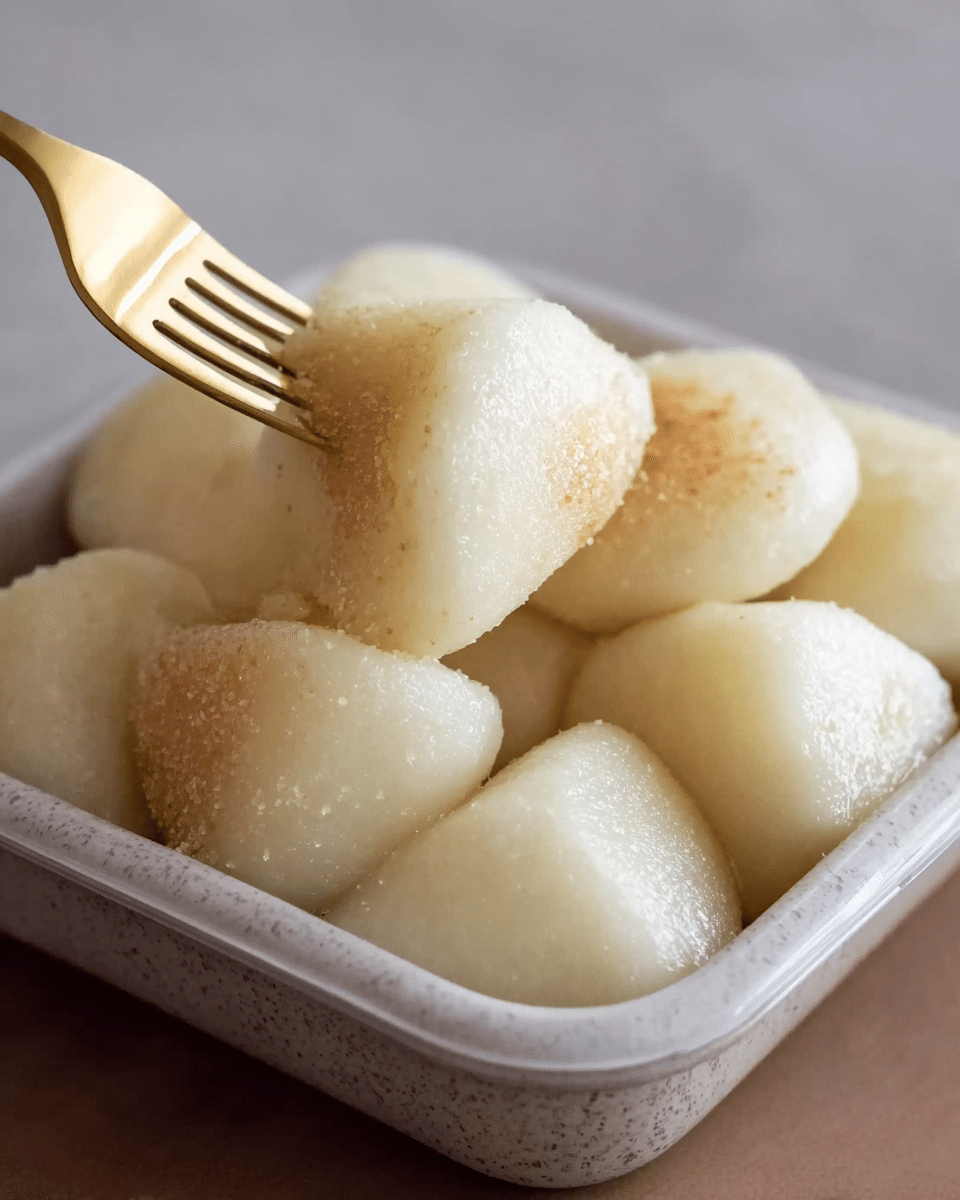The Beauty of Mochi
Mochi is a traditional Japanese dessert made from glutinous rice, known for its chewy, elastic texture. The process of making mochi involves pounding steamed glutinous rice into a sticky paste, which can then be shaped and enjoyed. While the texture of mochi can be quite unique—offering a chewy, almost doughy sensation—it’s this characteristic that makes it so beloved. Milk mochi is a modern twist on the classic recipe, incorporating the richness of milk for an even creamier, more indulgent flavor. Unlike other mochi varieties that may require specialized equipment or ingredients, milk mochi simplifies the process while retaining the authentic, beloved texture.
Key Ingredients for Milk Mochi
The beauty of milk mochi lies in its simplicity. The key ingredients include glutinous rice flour, cornstarch, sugar, corn oil, and whole milk. Each of these components plays an important role in creating the perfect mochi texture and flavor. Glutinous rice flour, or “mochi flour,” is the foundation of the dough, giving it the signature chewy and sticky texture. The cornstarch helps to firm up the mixture and prevents it from becoming too sticky, allowing it to hold its shape during cooking. The sugar adds sweetness, while the corn oil helps create a smooth and glossy texture. Finally, whole milk contributes a creamy richness, elevating the flavor profile and making this treat even more satisfying.
Cooking the Mochi Dough
To make milk mochi, all the ingredients are mixed together and then cooked over low heat. The slow cooking process is essential for allowing the dough to come together and become cohesive. Stirring constantly ensures that the mixture doesn’t burn and that the texture remains smooth. As the mixture cooks, it gradually thickens and forms a cohesive mass. Once fully cooked, the dough will have a glossy, smooth texture that’s easy to knead and shape. The key to perfect milk mochi is ensuring that the dough is fully cooked and that it reaches the right consistency before cooling.
Kneading the Dough
Once the dough has cooled enough to handle, the next step is to knead it. This part of the process is crucial for developing the elastic texture that is characteristic of mochi. Kneading helps to activate the glutinous rice flour, allowing the dough to stretch and pull as it becomes more elastic. When kneading, it’s important to wear gloves to prevent the dough from sticking to your hands, and to be patient as you work the dough into a smooth, stretchy consistency. The more you knead the dough, the more elastic and chewy the final mochi will be. After about five minutes of kneading, the dough should be soft and elastic, ready to be shaped.
Shaping the Milk Mochi
Once the dough is kneaded to the desired consistency, it’s time to shape it into small pieces. In traditional mochi recipes, the dough is often shaped into round balls, but for milk mochi, you can get creative with your shapes. Rolling the dough into a long strip and then cutting it into triangles or rectangles is a common method. To ensure that the dough doesn’t stick during shaping, you can sprinkle some cooked glutinous rice flour onto the surface. This helps keep the mochi pieces from sticking to each other or to your hands as you cut them. You can also experiment with other shapes, such as circles or squares, depending on your personal preference.
Coating the Mochi with Roasted Soybean Flour
One of the classic ways to enjoy mochi is by coating it with roasted soybean flour, also known as “kinako” in Japanese cuisine. This flour adds a nutty, slightly sweet flavor that complements the chewy texture of the mochi. The roasted soybean flour is easy to prepare and can be found in most Asian grocery stores. Simply dust the shaped mochi pieces with the roasted soybean flour, ensuring that each piece is evenly coated. This coating not only adds flavor but also gives the mochi a lovely, powdery appearance, making it visually appealing as well as delicious. You can also experiment with other coatings such as coconut flakes, powdered sugar, or even matcha powder to give the mochi a unique twist.
Serving and Enjoying Milk Mochi
Milk mochi can be enjoyed right after it’s made or stored in an airtight container for later consumption. The best time to enjoy milk mochi is when it’s freshly made, as the chewy texture is at its peak. The soft, elastic consistency of the dough combined with the creamy flavor makes this treat a comforting snack or dessert, perfect for any time of day. Milk mochi is versatile enough to be enjoyed plain or with your favorite coatings, allowing you to customize the flavor and presentation according to your tastes. It’s an ideal treat to serve at a family gathering, with friends, or as a special homemade snack.
Why Milk Mochi is So Popular
There are several reasons why milk mochi has become such a popular treat. First and foremost, it offers a unique texture that’s both chewy and satisfying. The soft, elastic dough creates a pleasurable eating experience that is different from most other desserts. Additionally, the rich, milky flavor is comforting and indulgent, making it a perfect treat for those who enjoy creamy desserts. The simplicity of the recipe is another factor that makes milk mochi so appealing. It requires only a few basic ingredients and minimal preparation, making it accessible for both novice and experienced cooks. Finally, the versatility of milk mochi means it can be enjoyed in many different ways, whether coated with roasted soybean flour, dusted with powdered sugar, or enjoyed plain.
Health Aspects of Milk Mochi
While milk mochi is undeniably delicious, it also has a few health benefits. The use of whole milk provides a good source of calcium and vitamin D, both of which are essential for bone health. The glutinous rice flour used in the dough is also a good source of energy, as it’s rich in carbohydrates. Additionally, milk mochi is naturally low in fat, making it a relatively light dessert option compared to some other fried or cream-based treats. Of course, it’s important to enjoy this dessert in moderation, as it still contains sugar and can be calorie-dense depending on the amount of coating used.
Conclusion
Milk mochi is a simple yet indulgent dessert that combines the best of traditional mochi with a creamy twist. Its chewy texture and rich, milky flavor make it a comforting treat that can be enjoyed on its own or with a variety of coatings. The recipe is straightforward, requiring only a few ingredients and minimal cooking time, making it an ideal choice for those looking to try their hand at making mochi at home. Whether you’re making it for a special occasion, a family gathering, or just as a sweet snack, milk mochi is sure to become a favorite in your recipe collection. Its versatility, ease of preparation, and delightful texture make it a must-try dessert for anyone who loves simple, satisfying treats.






